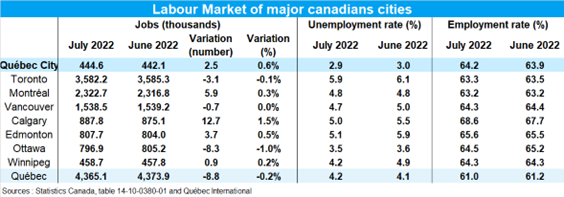Highlights
- The Québec City census metropolitan area’s (CMA) labour market grew slightly in July, with 2,500 additional jobs (+0.6%).
- The region’s labour market remains tight, as suggested by the 2.9% unemployment rate (-0.1 percentage points), the lowest in the province of Quebec and Canada.
- The Québec City CMA participation rate reached 66.1%, a 0.2 percentage point increase from the previous month. This rate is below what it was before the pandemic.
- Comparable data show that employment remained relatively stable in July in the province of Quebec (-0.2%) and Canada (-0.1%).
Charts
 Source: Statistics Canada. Table 14-10-0380-01.
Source: Statistics Canada. Table 14-10-0380-01.

Cautionary Note
The available data for the Québec City CMA was given special statistical treatment (three-month moving average) due to the small sample size, which has the effect of mitigating the large fluctuations in the data. Thus, the data collected in May and June influenced the estimations published for the month of July. Please also note that we use comparable data for the province of Quebec and the other CMAs in this document.
Commentary
Results from the Labour Force Survey (LFS) show an increase of 2,500 jobs in Québec City in July (+0.6%), the fifth consecutive monthly increase. In July 2022, there were 14,400 more jobs than in July 2021. The region’s labour market remains tight, with a 2.9% unemployment rate (-0.1 percentage points). This is the lowest rate in Quebec and Canada.
The participation rate, which represents the labour force expressed as a percentage of the population aged 15 and over, increased for the fourth month in a row, reaching 66.1% in July 2022. This is higher than the rate in July 2021 (65.1%). This result is explained by the increased participation of people aged 15 to 24 over the past year. There was little change in the main age category (25–54 years old) and the experienced workers category (55 years and over).
Despite this increased participation rate, labour market participation remains relatively low in the Québec City CMA. This situation, a result of the pandemic, may continue in the coming years due to the aging of the population. Indeed, the aging population puts downward pressure on the overall participation rate, which suggests that the labour scarcity issue is likely to persist.
Current labour market conditions, like the very low unemployment rate and the record high number of vacant positions, are happening while inflation in Canada is showing the highest annual variations in nearly four decades (+8.1% over 12 months in June). The employment situation is among the factors that most contribute to the increased cost of living.
Émile Émond
Economist
Québec International




